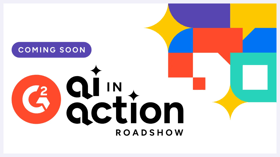June 16, 2025
 by Tanushree Verma / June 16, 2025
by Tanushree Verma / June 16, 2025

Remember when the biggest PR crisis was a typo in a press release? Those days feel charmingly quaint now that we're in a world where AI can write your entire communications strategy.
Between AI revolutionizing how we create content, social media becoming the primary news source, and employees turning into unofficial brand ambassadors, today's communications professionals need to be part strategist, part technologist, and part fortune teller.
It’s not just me saying this; industry leaders think the same. I recently had a conversation with Meredith Klein, author of "Meredith & The Media" Substack and former communications executive at Pinterest and Walmart. She talks about how AI is reshaping content creation without replacing the human touch, why authentic employee voices are becoming more powerful, and how communications professionals can use technology to work smarter.
Her advice: “Do not be afraid of change, rather embrace it. Being afraid of change is the fastest way to become irrelevant in today's evolving communications landscape.”
This interview is part of G2’s Q&A series. For more content like this, subscribe to G2 Tea, a newsletter with SaaS-y news and entertainment.
You've held communications leadership roles at major companies like Pinterest and Walmart. How have you seen corporate communications evolve throughout your career?
I've been in communications for 20 years, spanning agency work, startups, Fortune 500 companies, and now consulting. While I've witnessed tremendous growth and evolution throughout that time, the past five to seven years have brought the most significant transformation.
We are seeing the rise of ChatGPT and AI adoption, alongside increasing reliance on social platforms like LinkedIn and TikTok. Today's communications landscape is fundamentally social-centric.
Traditionally, we relied on print, online, broadcast, and radio channels, issuing formal statements and press releases. While the shift began over the past decade, it accelerated dramatically around 2020. Now, communicators routinely use social media to break stories and issue statements. Consider how President Biden would post directly on LinkedIn, Instagram, and X to distribute communications faster than organizing traditional press conferences.
Communications professionals are embracing what we call "new media" — Substacks, podcasts, vodcasts, and newsletters. While these formats aren't entirely new, their widespread adoption and strategic use represent a significant shift.
Unfortunately, our current economic climate has resulted in extensive newsroom layoffs. Veteran journalists with 20-25 years at major outlets like the Wall Street Journal and CNN are losing positions and launching independent platforms like Substack, bringing their expertise to personal media ventures.
Regarding today's AI focus, newsrooms are increasingly integrating artificial intelligence. Axios has embraced AI-friendly partnerships with OpenAI, while the Washington Post develops in-house AI to generate headlines and support AI-driven newsroom operations.
This convergence of AI, social media, and online platforms for rapid news amplification demands that communicators and marketers work more efficiently and effectively to match the pace of this new media environment.
In one of your LinkedIn posts, you mentioned a shift from corporate voice to expert voices. How do you identify and develop the right expert voices within an organization?
Today's consumers crave authenticity, expertise, relatability, and radical transparency. And honestly, they're even looking for a little bit of humor. We're witnessing a rise in executives appearing on video for earnings announcements, sitting casually at their desks to share results and thank employees. Doug McMillon, Chief Executive Officer of Walmart, has mastered this approach for years, and other CEOs are following his lead.
Executives are also stepping forward during challenging moments, demonstrating radical transparency by admitting when initiatives fail and explaining their pivot strategies. Today's consumers appreciate this authenticity and transparency, valuing companies that engage in genuine retrospection and communicate how they'll improve.
The evolution has moved away from heavily corporate and scripted communications toward more authentic, open, and radically transparent conversations. We're also shifting from relying solely on a handful of media-trained executives to leveraging broader expertise across organizations.
A significant trend I'm observing is the rise from brand-generated content to user-generated content (UGC), and now to employee-generated content (EGC). Employees can become powerful brand champions and ambassadors, not just sharing company news and launches, but providing insider perspectives on culture, experiences, and executive personalities that wouldn't emerge from pre-crafted, PR-written posts.
While PR professionals typically write social media messaging for C-suite executives, which is acceptable when executives provide input, edits, and authentic tone, there are limitations. AI-generated content will be transparent to audiences. Despite AI's various applications in communications, it cannot replace the human voice, element, or touch.
Authenticity, especially in communications from experts and CEOs, must remain personal and personalized.
Meredith Klein
Communications Leader and Substack Journalist
However, we'll see increased utilization of subject matter experts (SME).
There's tremendous value in leveraging SMEs across all levels, providing insider insights into culture and internal perspectives otherwise inaccessible. As Gen Z becomes the majority demographic, they're seeking authenticity, relatability, and radical transparency, making a balanced approach essential.
This is where internal communications become increasingly critical. And just as internal communications distributes memos and provides talking points for all-hands meetings, Q&As become essential, giving employees platforms to ask questions while providing context, insights, or clearly stating limitations.
Organizations must recognize that employees have platforms and voices, creating potential double-edged scenarios. They might share internal information inappropriately, but with respectful treatment, clear communication, and the radical transparency employees crave, we can distinguish between employees who might go off-script and those genuinely proud to serve as brand ambassadors.

Join industry leaders at G2's free AI in Action Roadshow for actionable insights and proven strategies to reimagine your funnel. Register now
Can you walk us through a specific example of how you've implemented AI-driven content analysis to identify white space opportunities in media coverage?
Sure! I can't share specific company names, but let me walk you through how I've implemented AI-driven content analysis to identify white space opportunities in media coverage.
AI excels at quickly pulling from millions of pieces of content to create executive summaries that would typically take PR professionals hours to compile. While we've always had the internet and Google for content aggregation, AI can accomplish this within seconds. The key is applying human oversight to verify credible sources and ensure information isn't outdated.
I worked with a company that was particularly focused on trend identification. We had an incredible data team using first-party data and SQL to identify surges in specific search engine optimization (SEO) patterns and consumer search behavior. However, I implemented AI as a cross-referencing tool to validate our findings and identify potential white spaces.
First, I use highly specific prompts in AI tools like ChatGPT or Gemini. The specificity of your prompt directly correlates to the quality of results, and I continuously refine prompts based on output quality. I'll ask AI to aggregate content and provide executive summaries that serve as starting points for strategic thinking. More importantly, I use AI to extract trends and identify white spaces in media coverage by analyzing patterns across massive content volumes.
Here's an example: During brainstorming sessions, our team generates multiple ideas. I run these concepts through AI to determine whether we're developing something genuinely new or inadvertently revisiting previously covered territory. This helps us either pivot to ensure innovation or recognize when we're touching on emerging trends that we can claim ownership of and amplify.
I also use AI to compile media targets, requesting top journalists in specific sectors. However, given the rapid pace of newsroom changes and beat switches, I always cross-reference AI results with platforms like Muckrack or LinkedIn to ensure accuracy.
While AI provides the foundational data aggregation, it requires human touch from experienced marketers and communications professionals.
Meredith Klein
Communications Leader and Substack Journalist
A marketer with years of experience can analyze aggregated data, whether from SQL databases or AI, and apply creative thinking to name trends, classify them, and develop strategic narratives.
The technology provides insider information, but it takes seasoned social media experts and communications professionals to interpret that data and declare, "Here's what's going to be trending." You can't achieve this strategic ownership through data aggregation or AI alone — it requires the balanced combination of both technological capability and human expertise. This approach has consistently helped identify genuine opportunities while avoiding redundant coverage areas already saturated in the media landscape.
How do you envision the relationship between communications teams and media outlets evolving over the next five years as AI continues to transform both industries?
There are a handful of media outlets that are starting to use AI, and there are also a handful of outlets that are not supporting the use of AI. So I would say that the impact on journalism will be pretty profound, presenting both opportunities and challenges.
The opportunities are significant; AI can free up time for investigative reporting by quickly pulling information, automating research tasks, and analyzing complex datasets. It can also assist with generating headlines and developing interview questions, helping journalists work more efficiently by freeing up time for other priority tasks.
However, AI should not replace actual article writing. This is where controversy emerges. Some newsrooms, particularly smaller or more resource-constrained operations, or syndicate organizations like News Corp or Newsmax, may turn to automated news writing using AI to generate entire articles. This approach drew widespread attention when the executive editor at the Washington Post opposed AI integration into newsrooms for precisely these reasons.
AI should help journalists save time on sourcing and analyzing information, but it shouldn't be used for direct reporting or writing actual articles. The fundamental issue is that AI content is only as reliable as its source material. If AI pulls from non-credible sites, biased sources, or outdated information, the resulting news becomes unreliable or inaccurate.
Journalists are deeply committed to the ethical integrity that defines their profession. They want to perform the rigorous research themselves to ensure the news and information they publish is factual, insightful, unbiased, and accurate. That represents journalism's highest standard and responsibility.
So, I personally don't believe AI will overtake newsrooms because it lacks the ethical human judgment that prompts journalists to double-check information or seek direct source confirmation. Journalists will always need person-to-person interactions — whether through live meetings, phone conversations, or email and text exchanges — to conduct fact-checking and confirmation.
What may evolve is the speed at which journalists can find information, aggregate data, and generate suggestions for topics, trends, and angles. AI can certainly assist with these tasks, but it will never replace the journalist's essential work of having those critical conversations and ensuring proper information exchange to confirm accuracy and facts before publication.
As we are talking about AI, what AI tools have you found most valuable for media relations work?
I love using two specific tools for recording and transcription. This is going to date me, but I used to carry a legal pad everywhere, taking so many notes that I barely looked up during meetings. I'd end up with pages of handwritten notes, then spend hours typing everything up afterward. Way too time-consuming.
Even when I transitioned to bringing my laptop to meetings, I was still furiously typing, missing important details while trying to capture what seemed most critical. Now I use either Fathom AI or Otter AI. This has been transformative because notes from executive meetings are absolutely critical.
Let me give you an example: Whether I'm building communications plans for executives or conducting executive intake sessions, their time is incredibly valuable. I cannot rely on myself to ask questions, maintain eye contact, and take comprehensive notes during a 30-minute meeting. I need AI tools to capture everything they say. Some executives prefer not being recorded by AI — understandably concerned about data security — but when permitted, these tools allow me to categorize content better afterward.
I can identify the key themes from executive conversations and focus on what's truly top-of-mind for them, streamlining my approach to building targeted media strategies and content around their priorities.
I also use Sprout Social for social media management and aggregation. As a PR professional, I rely on Grammarly. While I consider myself a strong writer, words can blur together, and Grammarly catches typos and helps maintain AP style proficiency. I use ChatGPT and Microsoft Copilot for quick information gathering and overcoming writer's block. When I'm stuck, I'll input exactly what I'm trying to accomplish, and these tools provide starting points that get my creative process flowing.
In your experience, what emerging trends are you seeing in AI adoption across the communications industry, and how are professionals staying ahead of these changes?
We’re seeing specialized companies emerge in this space. I took an AI class through The Media Copilot, hosted by Pete Pachal, a longtime reporter who now offers classes, webinars, and newsletters specifically for journalists and communications professionals on AI applications. His training provided many of the tools and prompts I use today.
PR agencies are developing proprietary AI models. Hotwire Global recently announced Hotwire Spark for analyzing data, insights, and measurement. This tool provides clients with sentiment analysis and media coverage insights while maintaining human strategic oversight. The Washington Post developed Haystacker, an in-house AI tool that helps journalists sift through large datasets —video, photos, and text — to identify trends and patterns.
We're seeing former journalists launch AI education brands, established agencies create AI labs, and major media outlets develop custom tools. As AI dominates news cycles, experts are teaching themselves these technologies and then educating those of us slower to adopt simplified, accessible approaches.
However, you must be cautious about what information you input into AI systems. The Samsung incident, where confidential yearly planning information was inadvertently leaked through AI, serves as a critical reminder. Journalists are equally thoughtful about AI usage. Major outlets like The New York Times, Washington Post, and Wall Street Journal aren't using AI extensively for article writing, but news aggregators and smaller publications are increasingly using automated AI for summarizing and syndicating content from larger outlets.
This creates a cycle where AI-generated articles populate search results, making human fact-checking and final editorial oversight even more crucial. The balance remains essential — leveraging AI efficiency while ensuring expert marketing and communications professionals provide accuracy, authentic brand voice, and the human touch that makes content resonate, remain factual, and feel personalized and compelling to audiences.
Beyond the conceptual, what specific AI tools or platforms are you currently using that have delivered the most value, and do you have any advice for communications leaders who are just beginning to implement AI in their strategy?
Don't be afraid of AI. AI won't replace marketers and communicators but will make them more effective. Take initiative with your professional development. Most companies offer learning and development budgets, so invest in an AI course or ask your agency to provide AI insights and training sessions.
Start experimenting on your own with ChatGPT and other available tools. If you're new to AI, be smart about what you share. Never input internal communication strategies, confidential information, or proprietary data. Instead, practice with safer content like rewriting your bio, creating briefing documents, or asking general questions. Pay attention to the output quality and how much time you spend correcting it. This will help you identify where AI provides effective shortcuts and where you need to apply your expertise to ensure accuracy.
Consider building media plans that integrate with how AI search engines function. For example, Axios and The Atlantic are AI-friendly because of their partnerships with OpenAI, meaning their content often appears in AI aggregates. Some publications may limit or block AI access, which doesn't mean you should avoid pitching them. Just understand that placements there might not surface in AI searches.
This reinforces why I advocate for media outlet diversification. While it's still important to target Fortune and The New York Times, ensure you're also present in Substacks, newsletters, podcasts, and social platforms. Despite claims that hashtags are dead, I disagree. People still use hashtags to discover specific content and research topics, so I remain a proponent even though LinkedIn experts claim the hashtag algorithm doesn't work.
Newsrooms, marketers, and social platforms have all transformed, requiring us to constantly understand changes, test and learn, and thoughtfully experiment.
Meredith Klein
Communications Leader and Substack Journalist
Be willing to try something, fail, analyze where you failed, adjust your approach, and try again. Then share those insights with others. There's no point in gatekeeping information and learning. Competitors will eventually discover your methods anyway, so why not contribute to making internet content better by sharing what you've learned? Help others by saying, "I made this mistake, don't repeat it," or "This tool is most credible," or "Here's the best path forward – any suggestions?"
We should be sharing information, absorbing insights, and digesting knowledge in ways that make us smarter, more effective, more efficient, and more transparent. This approach creates cleaner, more concise, more relevant content while dismantling misinformation, because people are willing to demystify what doesn't work and share what does.
If you enjoyed this insightful conversation, subscribe to G2 Tea for the latest tech and marketing thought leadership.
Follow Meredith Klein on LinkedIn to keep yourself updated on the world of communications and PR.
Edited by Supanna Das
Tanushree is an Editorial Content Specialist at G2, bringing over 3 years of experience in content writing and marketing to the team. Outside of work, she finds joy in reading fiction and indulging in a good rom-com or horror movie (only with friends). She is an enthusiastic dancer, a lover of cat reels, and likes to paint. A dedicated Swiftie, Tanushree also has a deep love for Hindi music.
Achieving concrete business results with social media is no easy feat.
 by Sudipto Paul
by Sudipto Paul
Even as a newly minted organization, UpContent knew that the customer voice is a critical...
 by Erin Boyd
by Erin Boyd
In the hyper-competitive world of business, your ability to retain customers can be the...
 by Savan Kharod
by Savan Kharod
Achieving concrete business results with social media is no easy feat.
 by Sudipto Paul
by Sudipto Paul
Even as a newly minted organization, UpContent knew that the customer voice is a critical...
 by Erin Boyd
by Erin Boyd


